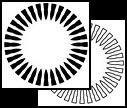 |
|||
 |
|||
|
TATTOO DESIGNS & SYMBOLS - CIRCLE TATTOOS
Tattoo Symbol Index - A B C D E F G H I J K L M N O P Q R S T U V W X Y Z Tattoo designs - C >> Circles
You can hardly go wrong by choosing the circle as a tattoo motif. From the minimalist Zen circle, to an intricate Celtic knotwork ring, to any kind of motif manipulated into a circular shape, the circle is instantly understood as a sign of wholeness. To wear a circle tattoo is to make a statement about your inner optimism and sense of inclusiveness - just as the wedding ring has long been used to express an inner commitment to fidelity and eternal love. It is no accident that tattooed bands on fingers have become nearly as popular as a gold band in some circles... Twenty five hundred years ago, the Buddha chose the Dharma Wheel as a teaching aid to represent the endless cycle of 'samsara' (continual rebirths on earth). Liberation or freedom was possible if we stopped identifying with all the action at circumference of the wheel, and gravitated to the circle's centre, a place of pure observation. Early students of Buddhism also took the wheel to represent their master's teachings, and how it could roll through a person's life inspiring radical spiritual change. Prior to that, the Egyptians, Phoenicians and Greeks lent great significance to the circular motif of the snake eating its own tail. This 'Ouroboros' was symbolic of the cyclical nature of creation-destruction-renewal-death-once-more-then-birth-and-on-like-that-forever-amen. Evidence of the circle's application by prehistoric peoples is nowhere more obvious than at Stonehenge in southern England. A circular arrangement of monolithic stones reflected an clear understanding of the relation of earth to the heavens. It was used as an astronomical clock, as well as a burial ground.
Native Americans, especially nomadic tribes living on the vast plains, lived by the circle. They often lived within it, in the form of a teepee. Their mysterious medicine wheels were rings of stones in which healing and teaching and other ceremonies and rituals were held. It was a place of safety and protection, especially the hub, which was the point of eternal stillness. As such, it was the symbolic doorway to the spirit world. Four lines emanated from the circle's centre to the spirits of the four cardinal directions. Even today, the tradition of the 'talking circle' makes powerful use of the circle's quality of inclusiveness. Says Native-Canadian architect, Douglas Cardinal, "When you put your knowledge in a circle, it's not yours anymore - it belongs to everyone." Human beings in a circle face inwards and find themselves face-to-face. Amidst the overwhelmingess of all that surrounds us, Cardinal insists, we need to focus inwards to strengthen ourselves. Circles as sacred space was a concept well known to the Celts. Drawing a circle acted as a protective boundary to keep out evil and enemies alike. Modern-day pagans still utilize the circle as their foremost device for getting in touch with the energy of the goddess. The Celtic Cross combines the ancient circle with the almost-as-ancient cross. This powerful symbol appears to have been co-opted by Christians such as Saint Patrick, but in any case, the circle imbues the cross with a special sacredness. It both invites the believer inwards and contains the sacred power that is present. It's not unlike the halo that radiates from the bliss of a saint's salvation.
Among Hindus, the red dot - or beauty spot - worn between the eyes represents the inner eye, which has a vastly larger perspective on reality. The dot is called a 'bindi', and represents the male force. When appearing within a circle, it symbolically brings together both the female and male energies. Wherever circles are used symbolically, they never fail to command our attention. From crop circles to Zen circles, from the five rings of the Olympic symbol to the opposites embraced by the yin-yang symbol, circles somehow satisfy us. Perhaps it's because, as shapes, they have maximized their potential. Designing a circle tattoo implies that you, too, strive for perfection. See also: Zen Circle, Spiral Designs, Celtic Knots, Ouroboros, Infinity, Yin-Yang, Moon and Sun Designs Tattoo designs - C >> Circles Tattoo Symbol Index - A B C D E F G H I J K L M N O P Q R S T U V W X Y Z |
||
| Celeb Tattoos | Facts & Stats | Designs & Symbols | History | Culture | Links | Tattoo Galleries | Contact | |||
|
|
|||




